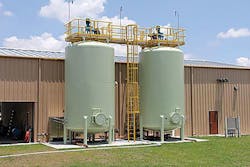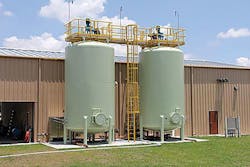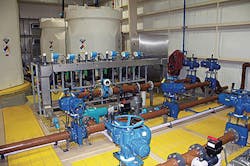Wastewater Plant Becomes Model of Energy-Efficient, Low-Cost Operation
Facing new biosolids regulations from the Florida Department of Environmental Protection (FDEP) that limited land application of Class-B biosolids, Haines City seized the opportunity to adopt a process that also solved a host of other looming challenges. Escalating energy costs, complaints about odors, digester capacity limitations, rising operating expenses, and limited capital for process enhancements were all issues that concerned city and utility officials.
The Neutralizer process from BCR Environmental, which Jacksonville, Florida-based NuTerra implemented, enables the city to treat biosolids more easily while producing odor-free residuals and a product for beneficial reuse/land application - all while cutting operating costs and meeting FDEP provisions. The process produces nutrient-rich Class-AA/EQ (exceptional quality) biosolids registered with the Florida Department of Agriculture as a commercial fertilizer and meets the state’s strict nutrient and pollutant limits with an extremely low Phosphorus Source Coefficient of 0.1.
Huge Savings
“Our Neutralizer system goes above and beyond meeting Florida’s provisions,” explained Haines City Utility Director Mike Stripling. “The financial advantages are huge. We’re saving approximately $133,000 per year in total biosolids treatment and disposition costs (net after our Neutralizer financing costs), which adds up to around $4.8 million over 20 years. Plus, we avoided spending $2.75 million in having to upgrade the old digesters and purchase new dewatering equipment.”
Installation of the dual-train Neutralizer system with a centrifuge for sludge dewatering was completed in a new 5,000-square-foot building on the site of the plant’s unused drying beds in late 2011 and began operations the following March. The DEP provided a loan for the $4-million project at 2.6 percent interest; payback is on track for five years. The 3-MGD (design) activated sludge plant has an average flow of about 1.5 MGD, and effluent is sent to the city’s reclaimed water system.
Highly Energy Efficient
With Neutralizer’s two-stage chemical system treating the waste activated sludge, the plant eliminated three digesters (each with two 125-horsepower motors) and the odors they generated. This change alone reduced the city’s energy costs from an average of $333,000 per year to approximately $9,000 per year.
Another energy-related cost-savings driven by the Neutralizer system is a huge reduction in loads hauled each month, according to Nathan Silveira, licensed operator and interim pretreatment coordinator at the plant. “We used to haul 45 to 55 loads a month. Now we haul 12 to 15, and our transportation costs went from up to $15,000 a month down to $6,000,” he said. “It means we’ve reduced our carbon dioxide emissions by 617 metric tons annually - that’s like taking 130 cars off the road.”
Instead of having to pay for hauling and dumping malodorous sludge in the landfill, Haines City uses the concentrated fertilizer. A trucking company picks up the Class-AA biosolids trailer and applies it on nearby pastures; it’s also used on city properties, such as parks and boulevards. The treatment improvement now allows the city to sell the biosolids as commercial fertilizer for $250 per 36,000-pound truckload.
Simpler, Cleaner, Faster Process
In addition to being more energy efficient, the automated Neutralizer process has helped lower effluent turbidity and makes it easier and cleaner for operators.
“Under our old system, when biosolids went to the drum thickeners, our return activated sludge was loose one day and thick another,” said Silveira. “We didn’t know exactly how much solids we were removing - now we do. We improved our effluent turbidity and consistently stay at 0.2 NTU or lower. It has made a difference in how the plant runs, and we saw that difference relatively quickly.”
After treatment, the odorless neutralized biosolids are sent to a centrifuge that dewaters to 19- to 24-percent solids, versus 12-percent with the drum thickeners. The dewatered material is then automatically transferred to a trailer with a built-in spreader. “We can fill the process tank in the morning, treat it [and] dewater it in the afternoon for pickup the next day,” Silveira said. “It used to take a month to fill a digester, then 40 days for aerobic digestion, which created odors and used electricity the whole time.”
He further explained that the automated system also makes it easier for operators. “We have many more parameters to watch on the monitors and cameras so we can see all the different areas,” he said. “If the trailer is getting full or if I have to do something else, I pause the system.”
There is no material that splashes out of the digesters to clean up, and samples are taken from built-in ports. “I don’t get messy anymore,” Silveira said. “I’m not exposed to the raw sludge nearly as often, and I don’t have to deal with the weather or odors.”
Next Chapter: Organics Recycling Facility
The groundbreaking for a new organics recycling facility at Haines City’s current wastewater treatment property site took place in May 2015. The city will own the building that NuTerra designed, is constructing and will maintain. Further, the facility will blend residents’ yard waste with wastewater treatment biosolids and other organic waste accepted from surrounding communities and commercial interests. NuTerra will market the resulting federal- and state-approved Class-AA/EQ compost product for unrestricted beneficial reuse locally and in surrounding communities.
The facility’s process control system - NuTerra’s proprietary design - will continuously monitor and automate the composting process. It’s a streamlined approach that eliminates the need to reposition probes and avoids disruption of the process from exposure to rain, humidity and other factors that impact the active composting and curing processes. While greatly simplifying the process, this approach ensures a high-quality end product and minimal odor nuisances for nearby neighbors.
“NuTerra is making it economically possible to live up to our state’s high environmental standards. By recycling and beneficially reusing biosolids, yard waste and other organic waste, we’re reducing disposition costs with far fewer trips to the landfill and mitigating nutrient and groundwater pollution,” Stripling said. “The facility will provide surrounding communities an economically and environmentally advantageous outlet for their organic waste.” In addition, offsetting the use of commercial fertilizers with compost by the local athletic fields will result in superior water retention properties and allow for the slow release of beneficial nutrients.
More WaterWorld Current Issue Articles
More WaterWorld Archives Issue Articles


